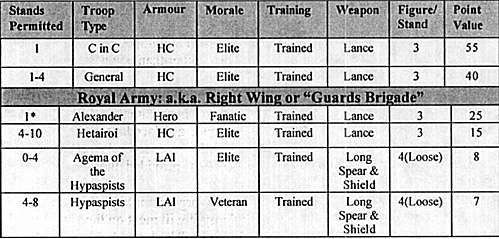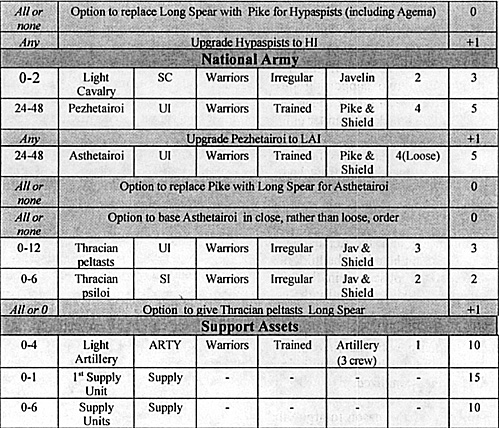Historical Themes
The role of Philip is now well understood as the founder of the formidable Macedonian national army (read Ellis [1976]). Philip shrewdly and skillfully constructed the foundation upon which Alexander's empire was founded; is it not unlikely that had Alexander and his mother Olympias not managed to kill him off, we'd be gaming the campaigns of "Philip the Great". Nonetheless, as careful examination of the lists below reveals, Philip's army was not the combined arms force that Alexander took into Asia. At Chaeronaea, the Macedonian OB - the basis for this list -- employed far fewer, and practically no light, cavalry. Missing too are the famed specialist units, such as the Cretan archers and the Agrianians, which were brought into play after Philip's death.
Philip developed an inner circle of close companions/nobility who served him well building the Macedonian state, and later served Alexander's megalomania as well. Prominent members of this group are Antipater, Parmenion, and Antigonos (Monophthalomus, "one-eyed"). The young Alexander served an apprenticeship under their tutorage; his battlefield exploits were much the product of his own raw athleticism and impetuosity. Thus, for the purposes of this list, Alexander is an AW hero, rather than a general.
Tactics
The Macedonian army at Chaeronaea was predominantly an infantry army, employing 12 brigades (taxeis) of phalangites of approximately 1600 men each. In AW, at the chosen scale of 200 men/stand, a Macedonain taxeis is well represented by a unit of 8 stands. The royal army, comprising the Hetairoi cavalry (c.a. 1800) and the Hypaspists (2400+), provided the mobile striking force.
There is little variety in this army, but its large complement of close order pikemen is more than a match for most infantry it will meet on the gaming table. Potential Philips must closely watch their flanks. The lack of skirmishers, apart from the tiny contingents of SC and Thracian psiloi, makes this army particularly vulnerable to enemy missile fire; players will find a battery of light artillery a handy asset to have on hand to shoot-up formations of enemy foot bows. Wedges of companion cavalry, hiding safely behind the front-line phalangites, should sally forth through special purpose lanes to strike at targets of opportunity as they present themselves. The fanatical, heroic Alexander - although a challenge to control - is the perfect weapon to deliver the decisive blow.
Against the Greeks at Chaeronaea, the combination of pike and shock cavalry eventually proved decisive, although the battle was a hard fought, close run affair. The AW model of deep ranks of pikemen "rolling over" opposing infantry in the initial round of melee was not necessarily the nature of the actual confrontations. Rather, the Macedonian phalangite, fighting with his companions in closely ordered ranks, was capable of utterly deflating the impetus of an enemy assault. Once their momentum was broken, the disordered ranks of the enemy could be herded into oblivion, aided and abetted by the superb Macedonian cavalry. If the enemy infantry maintained order, the pikemen would be in for a serious battle of attrition, which certainly characterizes the last stand of Persia's Greek mercenaries at the Granikos. AW pike fights oft times resolve in this manner, so on balance pike fights in AW have a good historical "feel".
Philip's pikemen, lightly protected at best, found their advantage in their superb training and the novelty of their long pikes, which taken together checked in its tracks any intended shock of impact projected by the enemy, and re-directed it to their own advantage. The image of the heavily equipped Hellenistic phalangite, struggling to maintain unit integrity in large, inflexible phalanx blocks belongs to a later age.
Enemies Later Hoplite Greek, Later Illyrian, Thracia
Philip the Barbarian
(30,000/27,600 foot/2,400 horse: 1:50 stands 138 foot, 12 horse)
Notes
- Generals and Hetairoi cavalry may use wedge.
- Phalangites may be in mixed armour units.


More Armies of Alexander the Great
-
Introduction and Technical Terms
Philip the Barbarian to 336 BC
Alexander Invades Persia 335-330 BC
Pursuit to the East 330-327 BC
India 326-323 BC
The Alexandrian Imperial Army, 323 BC
Back to Saga # 84 Table of Contents
Back to Saga List of Issues
Back to MagWeb Master Magazine List
© Copyright 2002 by Terry Gore
This article appears in MagWeb (Magazine Web) on the Internet World Wide Web. Other military history articles and gaming articles are available at http://www.magweb.com